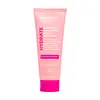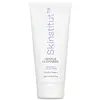What's inside
What's inside
 Key Ingredients
Key Ingredients

 Benefits
Benefits

 Concerns
Concerns

 Ingredients Side-by-side
Ingredients Side-by-side

Water
Skin ConditioningGlycerin
HumectantSodium Cocoyl Isethionate
CleansingSodium Chloride
MaskingCoco-Betaine
CleansingHydroxypropyl Starch Phosphate
Sodium Methyl Cocoyl Taurate
Cleansing1,2-Hexanediol
Skin ConditioningHydrogenated Coconut Acid
EmollientPotassium Cocoyl Glycinate
Sodium Isethionate
CleansingSodium Hyaluronate
HumectantSodium Acetylated Hyaluronate
HumectantHydrolyzed Hyaluronic Acid
HumectantHyaluronic Acid
HumectantHydroxypropyltrimonium Hyaluronate
Potassium Hyaluronate
Skin ConditioningSodium Hyaluronate Crosspolymer
HumectantAureobasidium Pullulans Ferment
Skin ConditioningBifida Ferment Lysate
Skin ConditioningAspergillus Ferment
Skin ConditioningBacillus Ferment
Skin ConditioningLactococcus Ferment
Skin ConditioningLactobacillus Ferment
Skin ConditioningSaccharomyces Ferment Filtrate
HumectantFructooligosaccharides
HumectantMaltodextrin
AbsorbentFructan
Skin ConditioningSorbitol
HumectantSalicylic Acid
MaskingTrehalose
HumectantBetaine
HumectantBeta-Glucan
Skin ConditioningSoluble Collagen
HumectantRosa Canina Fruit Oil
EmollientAllantoin
Skin ConditioningSorbitan Olivate
EmulsifyingCitric Acid
BufferingEthylhexylglycerin
Skin ConditioningDisodium EDTA
Parfum
MaskingWater, Glycerin, Sodium Cocoyl Isethionate, Sodium Chloride, Coco-Betaine, Hydroxypropyl Starch Phosphate, Sodium Methyl Cocoyl Taurate, 1,2-Hexanediol, Hydrogenated Coconut Acid, Potassium Cocoyl Glycinate, Sodium Isethionate, Sodium Hyaluronate, Sodium Acetylated Hyaluronate, Hydrolyzed Hyaluronic Acid, Hyaluronic Acid, Hydroxypropyltrimonium Hyaluronate, Potassium Hyaluronate, Sodium Hyaluronate Crosspolymer, Aureobasidium Pullulans Ferment, Bifida Ferment Lysate, Aspergillus Ferment, Bacillus Ferment, Lactococcus Ferment, Lactobacillus Ferment, Saccharomyces Ferment Filtrate, Fructooligosaccharides, Maltodextrin, Fructan, Sorbitol, Salicylic Acid, Trehalose, Betaine, Beta-Glucan, Soluble Collagen, Rosa Canina Fruit Oil, Allantoin, Sorbitan Olivate, Citric Acid, Ethylhexylglycerin, Disodium EDTA, Parfum
Water
Skin ConditioningGlycerin
HumectantDecyl Glucoside
CleansingAmmonium Lauryl Sulfate
CleansingXanthan Gum
EmulsifyingEthylhexylglycerin
Skin ConditioningLactic Acid
BufferingTocopherol
AntioxidantPanthenol
Skin ConditioningPhenoxyethanol
PreservativeOlea Europaea Leaf Extract
PerfumingLycium Barbarum Fruit Extract
AstringentPotassium Sorbate
PreservativeCamellia Sinensis Extract
AntioxidantAloe Barbadensis Leaf Juice
Skin ConditioningMaltodextrin
AbsorbentSodium Hydroxide
BufferingSodium Benzoate
MaskingCitric Acid
BufferingCucumis Sativus Oil
EmollientWater, Glycerin, Decyl Glucoside, Ammonium Lauryl Sulfate, Xanthan Gum, Ethylhexylglycerin, Lactic Acid, Tocopherol, Panthenol, Phenoxyethanol, Olea Europaea Leaf Extract, Lycium Barbarum Fruit Extract, Potassium Sorbate, Camellia Sinensis Extract, Aloe Barbadensis Leaf Juice, Maltodextrin, Sodium Hydroxide, Sodium Benzoate, Citric Acid, Cucumis Sativus Oil
Ingredients Explained
These ingredients are found in both products.
Ingredients higher up in an ingredient list are typically present in a larger amount.
Citric Acid is an alpha hydroxy acid (AHA) naturally found in citrus fruits like oranges, lemons, and limes.
Like other AHAs, citric acid can exfoliate skin by breaking down the bonds that hold dead skin cells together. This helps reveal smoother and brighter skin underneath.
However, this exfoliating effect only happens at high concentrations (20%) which can be hard to find in cosmetic products.
Due to this, citric acid is usually included in small amounts as a pH adjuster. This helps keep products slightly more acidic and compatible with skin's natural pH.
In skincare formulas, citric acid can:
While it can provide some skin benefits, research shows lactic acid and glycolic acid are generally more effective and less irritating exfoliants.
Most citric acid used in skincare today is made by fermenting sugars (usually from molasses). This synthetic version is identical to the natural citrus form but easier to stabilize and use in formulations.
Read more about some other popular AHA's here:
Learn more about Citric AcidEthylhexylglycerin (we can't pronounce this either) is commonly used as a preservative and skin softener. It is derived from glyceryl.
You might see Ethylhexylglycerin often paired with other preservatives such as phenoxyethanol. Ethylhexylglycerin has been found to increase the effectiveness of these other preservatives.
Glycerin is already naturally found in your skin. It helps moisturize and protect your skin.
A study from 2016 found glycerin to be more effective as a humectant than AHAs and hyaluronic acid.
As a humectant, it helps the skin stay hydrated by pulling moisture to your skin. The low molecular weight of glycerin allows it to pull moisture into the deeper layers of your skin.
Hydrated skin improves your skin barrier; Your skin barrier helps protect against irritants and bacteria.
Glycerin has also been found to have antimicrobial and antiviral properties. Due to these properties, glycerin is often used in wound and burn treatments.
In cosmetics, glycerin is usually derived from plants such as soybean or palm. However, it can also be sourced from animals, such as tallow or animal fat.
This ingredient is organic, colorless, odorless, and non-toxic.
Glycerin is the name for this ingredient in American English. British English uses Glycerol/Glycerine.
Learn more about GlycerinMaltodextrin is a polysaccharide. It is derived from starch such as rice, corn, wheat, or potato starch.
In food, Maltodextrin is used to improve the texture and thicken a product. Due to its structure, it can help create a gel texture. As an emulsion stabilizer, it helps keep the ingredients in a product together.
As a polysaccharide, Maltodextrin has moisturizing properties. Polysaccharides are a type of carbohydrate. The top layer of skin uses polysaccharides to retain water, keeping the skin hydrated.
Maltodextrin is water soluble and has a sweet taste.
Learn more about MaltodextrinWater. It's the most common cosmetic ingredient of all. You'll usually see it at the top of ingredient lists, meaning that it makes up the largest part of the product.
So why is it so popular? Water most often acts as a solvent - this means that it helps dissolve other ingredients into the formulation.
You'll also recognize water as that liquid we all need to stay alive. If you see this, drink a glass of water. Stay hydrated!
Learn more about Water